Search results for: 'Bronze a'
-
 Roman Republican denarius of Renius from Wishanger hoard
Roman Republican denarius of Renius from Wishanger hoardBiga driven by goats on reverse. Found 2021 in East Hampshire, UK. The hoard is a very impressive proof of the fact that coins were in circulation for up to several centuries in the Roman era.
Price: on request Augustus denarius from Wishanger hoard
Augustus denarius from Wishanger hoardReverse showing Caius Caesar galloping right, eagle between two vexilla behind him. Found 2021 in East Hampshire, UK. The hoard is a very impressive proof of the fact that coins were in circulation for up to several centuries in the Roman era.
Price: on request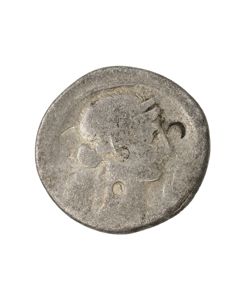 Octavian denarius from Wishanger hoard
Octavian denarius from Wishanger hoardShowing bust of Venus and Octavian in military dress. Found 2021 in East Hampshire, UK. The hoard is a very impressive proof of the fact that coins were in circulation for up to several centuries in the Roman era.
Price: on request Roman Republican L. Flaminius Cilo Denarius from Wishanger hoard
Roman Republican L. Flaminius Cilo Denarius from Wishanger hoardFound 2021 in East Hampshire, UK. The hoard is a very impressive proof of the fact that coins were in circulation for up to several centuries in the Roman era.
Price: on request Vespasian denarius from Wishanger hoard
Vespasian denarius from Wishanger hoardThe reverse shows the urn of Vespasian on a column. Great patina. Found 2021 in East Hampshire, UK. The hoard is a very impressive proof of the fact that coins were in circulation for up to several centuries in the Roman era.
Price: on request Augustus denarius from Wishanger hoard
Augustus denarius from Wishanger hoardFound 2021 in East Hampshire, UK. Revers showing Gaius and Lucius, the sons of M. Agrippa. The hoard is a very impressive proof of the fact that coins were in circulation for up to several centuries in the Roman era.
Price: on request Julius Caesar Denarius from Wishanger hoard
Julius Caesar Denarius from Wishanger hoardFound 2021 in East Hampshire, UK. The hoard is a very impressive proof of the fact that coins were in circulation for up to several centuries in the Roman era.
Price: on request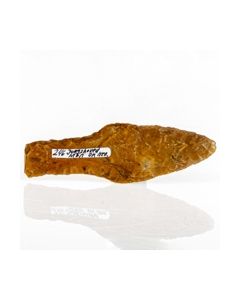 Scandinavian flint dagger
Scandinavian flint daggerNicely worked flint dagger from the transitional period between Late Neolithic and Early Bronze Age. Jungshoved on the Danish Island of Moen was the find spot.
Price: on request Neolithic sickle from Northern Germany
Neolithic sickle from Northern GermanySmall crescent-shaped blade made of beautiful polychrome flint. This tool represents an intermediate state within the radical transition from Neolithic to Bronze Age.
Price: on request Neolithic sickle from Denmark
Neolithic sickle from DenmarkCrescent-shaped blade made of beautiful brown flint. This tool represents an intermediate state within the radical transition from Neolithic to Bronze Age.
€700 Neolithic flint sickle from Denmark
Neolithic flint sickle from DenmarkCrescent-shaped blade made of beautiful brown flintstone. This tool represents an intermediate state within the radical transition from Neolithic to Bronze Age.
€530 Neolithic flint sickle from Denmark
Neolithic flint sickle from DenmarkCrescent-shaped blade made of beautiful reddish-brown flintstone. This tool represents an intermediate state within the radical transition from Neolithic to Bronze Age.
€520 Anglo-Saxon bow brooch
Anglo-Saxon bow broochA find from the Isle of Wight from the Migration Period. Beautiful testimonial of the settlement of Britain by the Anglo-Saxons.
Price: on request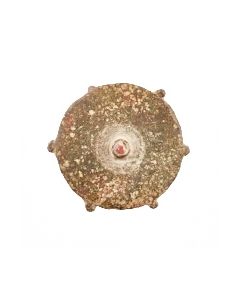 Roman plate brooch found at the Limes
Roman plate brooch found at the LimesAncient brooch with circular plate. Found near the Limes fortifications Pfoerring and Eining in Germany.
Price: on request Brooch from Roman Britain
Brooch from Roman BritainThis rare variant of the T-shaped brooches was found in Lechlade, Gloucestershire. It dates to the 1st or 2nd century AR. From the famous Hattatt collection and published in two standard works for ancient fibulae.
Price: on request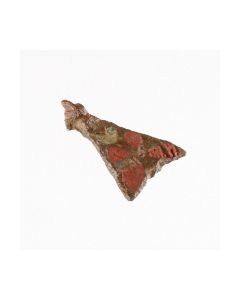 Roman cicada brooch
Roman cicada broochBrooch in the shape of an insect. Popular type in the northern Roman provinces during the 2nd century.
Price: on request Dolphin brooch from Roman Britain
Dolphin brooch from Roman BritainThe so-called dolphin brooch is very British. This specimen was probably made by the Celtic Corieltauvi tribe, shortly after the arrival of the Romans in the middle of the 1st century. Published in two works by Richard Hattatt.
Price: on request Anglo-Saxon gilt bow brooch
Anglo-Saxon gilt bow broochA find from the Isle of Wight from the Migration Period. Beautiful testimonial of the settlement of Britain by the Anglo-Saxons.
Price: on request Roman plate brooch with colourful enamel
Roman plate brooch with colourful enamelRare fibula type from Roman Britain. The fully intact multicoloured enamel makes this piece worthy of being a museum exhibit. 2nd cent. AD.
Price: on request Roman fibula in lozenge shape
Roman fibula in lozenge shapeAncient brooch in nice condition with remains of the original enamel inlays. Found near the Limes fortifications Pfoerring and Eining in Germany.
Price: on request Roman lock bolts from Novaesium
Roman lock bolts from NovaesiumPart of a key lock, e.g. for a door or chest. Finds from the Roman city of Novaesium, today's Neuss in Germany.
Price: on request Roman bronze chain
Roman bronze chainFox tail type chain fragment. A Find from the Roman city of Novaesium, today's Neuss in Germany.
Price: on request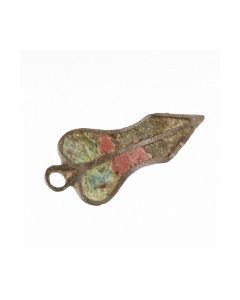 Roman brooch in dagger shape
Roman brooch in dagger shapeInteresting variant of the more common sandal brooch. The colourful enameled brooch has been made in the northern Roman provinces. 2nd cent. AD.
Price: on request Roman fibula with beautiful enamel
Roman fibula with beautiful enamelElaborate work dating to the 2nd century AD. The well preserved enamel is a testimony to the colourful world of ancient art.
Price: on request Celtic penannular brooch
Celtic penannular broochPossibly made by the Celtic Durotriges tribe under Roman rule in Britain. The piece is published in two books by Richard Hattatt.
Price: on request Roman bronze fibula
Roman bronze fibulaBrooch from the earlier Roman imperial period with a nice patina. This type of brooch was common in Central and Northern Europe. This very piece is from the Roman city of Novaesium, today's Neuss in Germany.
Price: on request Roman seal box with phallus
Roman seal box with phallusCircular body with protective phallus in high relief on the lid. A piece from the Roman Imperial period, found in North East England. Published in a standard work by Richard Hattatt.
Price: on request Anglo-Saxon bow brooch
Anglo-Saxon bow broochA find from the Isle of Wight from the Migration Period. Beautiful testimonial of the settlement of Britain by the Anglo-Saxons.
Price: on request Roman brooch of the Hod Hill type
Roman brooch of the Hod Hill typeBeautifully decorated brooch from the first century. A find from the Roman city of Novaesium, today's Neuss in Germany.
Price: on request Two Roman lock bolts from Novaesium
Two Roman lock bolts from NovaesiumEach was part of a key lock, e.g. for a door or chest. Finds from the Roman city of Novaesium, today's Neuss in Germany.
Price: on request Rare frog fibula
Rare frog fibulaZoomorphic fibula dating to the Roman Principate. Very nice enameled work. Rare variant of this popular fibula type from Roman Gaul.
Price: on request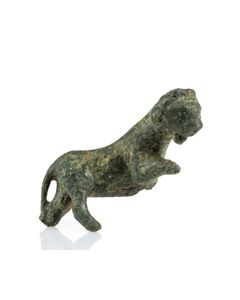 Roman bronze feline from the Rhineland with known finding year
Roman bronze feline from the Rhineland with known finding yearProbably a lion. Found 1968 near the Roman city of Novaesium, today's Neuss in Germany, an early Roman foundation and with this one of the oldest cities in Germany.
Price: on request Bow fibula of the Urnfield culture
Bow fibula of the Urnfield cultureExcessively rare brooch type from Late Bronze Age in Bavaria. It is known from the Urnfield period hoard of Reisen near Munich in Germany. This piece has been found near Regensburg, Germany.
Price: on request Celtic bracelet of the La Tène culture
Celtic bracelet of the La Tène cultureImpressive and solid bronze jewellery from the Early La Tène period, 450 to 250 BC. Found in Southern Germany.
Price: on request Roman fibula in the shape of a rabbit
Roman fibula in the shape of a rabbitNice zoomorphic roman fibula made of bronze with enamel inlays depicting the young of the rabbit. Found near the Limes fortifications Pfoerring and Eining in Germany.
Price: on request Gorgeous Roman Imperial fibula
Gorgeous Roman Imperial fibulaThe large bow is dominated by colourful enamel. It is a brooch type that developed during the 1st cent. AD in Central Europe.
Price: on request

